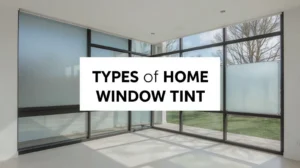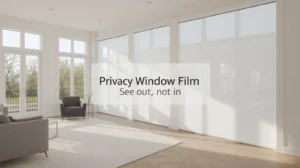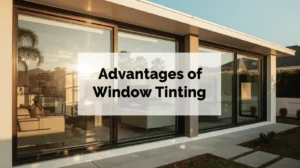The cost of window tinting is a common question among homeowners who want to save energy, improve comfort, and add privacy. On average, prices range between $5 and $12 per square foot, with larger windows, sliding doors, or high-performance films costing more. Factors like window size, film type, labor rates, and removal of old film all play a role in the final price. This guide explores every detail from average costs and installation methods to comparing ceramic, solar, and standard films so you can make a clear decision.
Understanding Window Film and Its Role in Homes
Window film is more than a dark sheet for glass. It’s a multi-layered product designed to improve the performance of windows. The thin film attaches directly to the inside surface of your glass, reducing glare and controlling the amount of sunlight that enters.
One of the biggest benefits is protection from UV rays, which can fade carpets, furniture, and flooring. Another advantage is comfort. By blocking heat, films help maintain even temperatures in your home, meaning your HVAC system doesn’t need to work as hard.
For many families, film installation is part of upgrading to a more energy-efficient home. While curtains and blinds add style, they don’t stop heat transfer as effectively as tinting. That is why homeowners often weigh the house window tinting cost against long-term savings.
Why Homeowners Look at Residential Window Tinting Cost
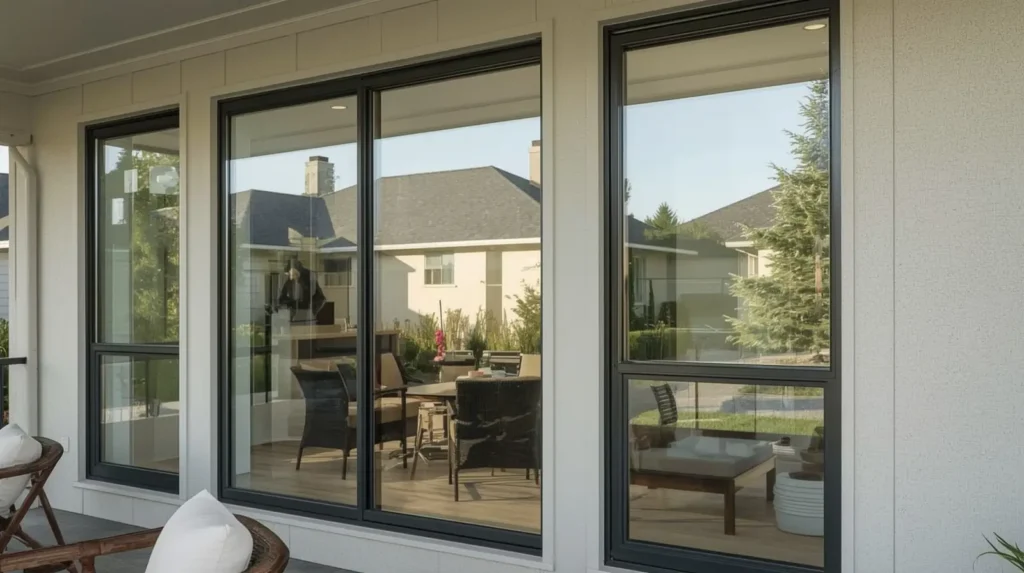
Energy bills are often a major concern, especially during summer when cooling costs rise. By lowering indoor temperatures, tinted windows reduce air conditioning usage. Over time, this benefit helps offset the residential window tinting cost.
Privacy is another factor. Many people want natural light without feeling like neighbors can see inside. Films allow sunlight while keeping interiors private, especially during the day.
Finally, safety matters. Certain films add shatter resistance, holding broken glass together during accidents or storms. This added layer of protection becomes a strong reason why some homeowners find the investment worthwhile.
Average Cost of Window Tinting for Homes
So, what’s the real answer to the average cost of window tinting?
For most homes, projects range from $300 to $1,000, but this depends on:
- How many windows are being tinted.
- The size of the glass.
- The type of film chosen.
Per square foot, expect to pay between $5 and $12. Entry-level films like dyed versions sit on the lower end, while ceramic tint home windows or solar films reach higher prices.
If your home includes oversized windows, bay windows, or glass doors, the total project cost will naturally increase. Still, the efficiency gains often balance out these upfront expenses.
Window Tinting Prices for Home: What Impacts Them?
Many homeowners ask why two quotes for window tinting prices for home vary so much. The answer lies in several cost drivers:
- Film quality: Standard dyed films cost less but may fade over time. Ceramic or solar films cost more but last longer.
- Window shape: Large, tall, or curved windows require more precision and time.
- Labor: Installers with years of experience may charge more, but the finish is flawless.
- Existing film removal: If old tint must be stripped, that adds to the bill.
- Geography: Prices differ between rural towns and larger cities.
By understanding these influences, you can better compare multiple estimates.
Cost of Window Film Installation vs. Buying Film Yourself
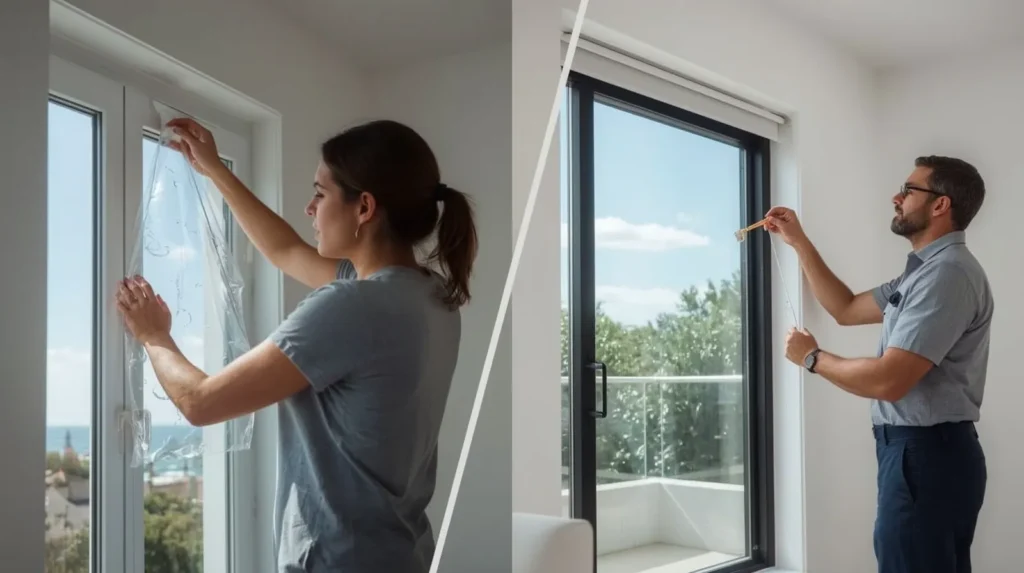
Buying rolls of film seems cheaper at first. Some films sell for $50–$100 per roll, covering several windows. However, the challenge lies in applying it correctly. Wrinkles, peeling, or trapped air bubbles make windows look messy.
Professional cost of window film installation includes preparation, precise application, and cleanup. Installers also guarantee their work, meaning the film won’t peel after a few months. While it may cost more upfront, the value is in the long-term results.
DIY may work for small decorative projects, but for entire homes, professional installation is the smarter investment.
Window Tinting Cost per Square Foot and per Window
Most contractors use two main methods of pricing:
- Window tinting cost per square foot: $5–$12. This method is common for large projects or unique window shapes.
- Window tint cost per window: $70–$250, depending on size and film type.
Smaller windows may seem inexpensive at first, but larger ones quickly raise the total cost. A sunroom, for example, with floor-to-ceiling glass can exceed $1,500 depending on the film chosen.
When requesting quotes, always ask if the company charges per square foot or per window. This helps avoid surprises on the final bill.
Key Factors That Affect the Cost to Tint House Windows
The cost to tint house windows isn’t one-size-fits-all. Here are the main influences:
- Film type: Ceramic or infrared-blocking films cost more than basic tints.
- Window design: French windows with multiple panes take longer to cover.
- Condition: Old, scratched, or dirty glass requires prep work.
- Accessibility: Second-story windows or skylights involve ladders or lifts, raising labor costs.
- Extras: Some homeowners request frosted films for design, which may add cost.
These small details explain why an online window tint cost estimate may differ from the in-person quote.
Ceramic Tint, Solar Film, and Other Options Compared

Choosing the right film is about balancing cost and performance. Let’s compare:
- Dyed film: Lowest price, but limited heat control.
- Metalized film: Reflects sunlight but can affect Wi-Fi or cell signals.
- Ceramic tint for house windows: Premium choice, blocks heat and UV without making rooms dark. The average cost of ceramic tint is higher, but durability is excellent.
- Solar film for windows cost: Built to improve energy efficiency, often chosen in sunny climates.
- Decorative films: Frosted or patterned designs, used mainly for privacy in bathrooms or offices.
Each option comes with different strengths. Families who value comfort and clarity often choose ceramic despite the higher price tag.
How Much Does It Cost to Tint Sliding Glass Doors?
Sliding doors are a focal point in many homes but also a source of heat gain. Because of their size, they cost more than regular windows.
- Cost to tint sliding glass doors: $150–$400.
- How much does it cost to tint sliding glass doors with ceramic film? Around $300–$500.
If your patio doors face direct sunlight, investing in a higher-quality film makes sense. The long-term cooling benefits and UV protection outweigh the initial bill.
Getting a Window Tint Cost Estimate in Nashville with Tint Solutions Tennessee
When planning your project, the best step is to get a professional window tinting estimate. In Nashville, Tint Solutions Tennessee provides accurate pricing based on window size, film type, and installation method.
They offer clear breakdowns so homeowners can compare home window tinting prices and choose the best option for their needs. Local expertise also ensures that the recommended film suits the climate and lifestyle of your area.
Is Home Window Tinting Worth the Price Long Term?
For many people, the big question is: Is it worth it? The answer is yes, for most homes.
- Energy savings: Lower power bills offset the investment within a few years.
- Protection: Furniture, artwork, and flooring last longer with less fading.
- Privacy: Tinted windows allow natural light while shielding your space.
- Comfort: Fewer hot spots and glare make rooms more enjoyable.
While the tinting windows cost may seem high upfront, the benefits extend for years. Compared to replacing windows, film installation is a more affordable improvement with fast results.
Final Thoughts
The cost of window tinting varies depending on film type, glass size, and installation method. On average, expect $5–$12 per square foot, with ceramic and solar films on the higher end. Sliding glass doors and specialty windows add to the price, but the benefits in comfort and savings make the investment worthwhile.
Ready to see the difference for yourself? Contact Tint Solutions Tennessee today for a detailed cost estimate and discover how much you can save while upgrading your home’s comfort.

